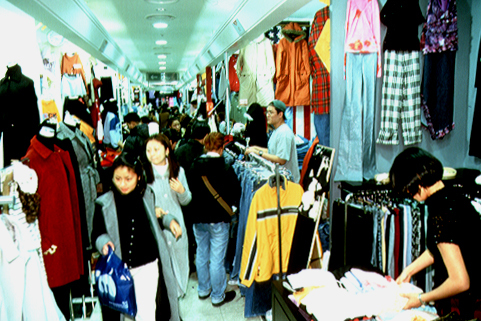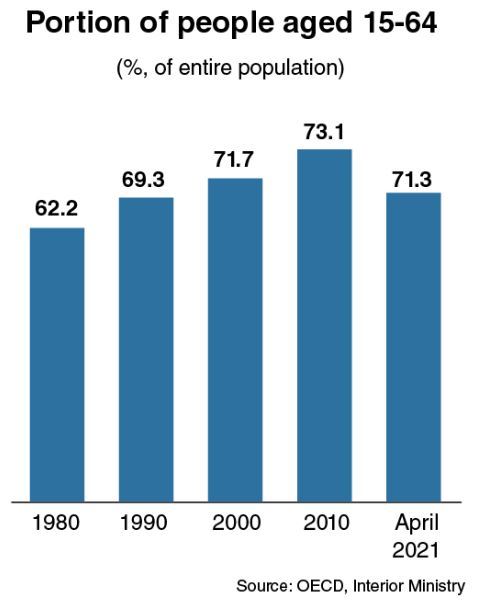 |
This photo shows an underground shopping arcade in Myeong-dong, Seoul in 2001, when the portion of population that was of working age was still increasing. (National Archives of Korea) |
SEJONG -- South Korea is the only country whose labor force exceeds 70 percent of the total population in the 37-member Organization for Economic Cooperation and Development.
The high percentage of the working age population -- people aged between 15-64 -- among Korea’s total inhabitants has greatly contributed to the nation’s economic growth over the past few decades.
Their share of the population reached 72.8 percent in 2018, far surpassing Japan’s 59.7 percent and the OECD average of 65.1 percent -- as the highest figure among those held by the 37 members.
Korea saw the working age percentage of the population steadily climb from 54.4 percent in 1970 to 62.2 percent in 1980, 69.3 percent in 1990, 71.7 percent in 2000 and 73.1 percent in 2010.
But the working population has faced a decline since the mid-2010s after it peaked at 73.4 percent in the early 2010s in the wake of the rapidly growing elderly population who are aged 65 or over.
 |
(Graphic by Kim Sun-young/The Korea Herald) |
According to the Ministry of Interior and Safety, the percentage of those aged 15-64 slid to 71.3 percent as of April, which marked the lowest in 25 years.
The situation has fueled worries added to by shrinking labor productivity and a hike in social welfare costs for taking care of seniors, which could ultimately undermine the GDP growth and national competitiveness.
Further, data held by Statistics Korea show that the proportion of those aged 15-64 is on course to fall below 70 percent to 69.9 percent by 2024.
The state-run agency also predicts that this figure would fall to 59.8 percent in 2036 and 49.9 percent in 2056.
The working age population is forecast to be outstripped by the graying population in 2065 -- at 45.9 percent vs. 46.1 percent. These estimates are based on the Korea’s possession of the world’s lowest-level fertility rate, which has been under 1.0 since 2018.
As of April, the number of children under 10 years of age was only 3.89 million -- putting this age bracket at the bottom of the rankings among age groups under 70 in Korea.
People in their 50s topped the list with 8.6 million, followed by those in their 40s with 8.24 million, those in their 30s with 6.8 million and those in their 20s with 6.76 million.
In addition, those aged 60-69 far outnumbered people aged 10-19 at 6.91 million to 4.75 million. The number of those aged 70-79 reached 3.69 million.
For a wider comparison, the number of people aged 0-19 (8.64 million) was fewer by more than 1.9 million than people aged 60-79 (10.61 million) as of last month.
The OECD data showed that Korea recorded a fertility rate of 4.5 in 1970 and 2.8 in 1980. Though it fell to 1.6 in 1990, that level though relatively low, was still enough to ensure a sustainable working age population. But it continued to slide in the 1990s and 2000s and posted 1.2 in 2010.
According to Statistics Korea, the fertility rate for 2018 was 0.977, falling below the 1.0-mark for the first time in history, and since then has declined to 0.92 in 2019 and 0.84 in 2020.
Most of the baby boomer generation in Korea, born between 1955 and 1963, still belong to the working age population.
But as those born in 1956 will turn 65 this year, the baby boomers are exiting the working age range. The working age population is therefore expected to shrink faster in the 2020s.
By Kim Yon-se (
kys@heraldcorp.com)






![[Exclusive] Hyundai Mobis eyes closer ties with BYD](http://res.heraldm.com/phpwas/restmb_idxmake.php?idx=644&simg=/content/image/2024/11/25/20241125050044_0.jpg)
![[Herald Review] 'Gangnam B-Side' combines social realism with masterful suspense, performance](http://res.heraldm.com/phpwas/restmb_idxmake.php?idx=644&simg=/content/image/2024/11/25/20241125050072_0.jpg)

